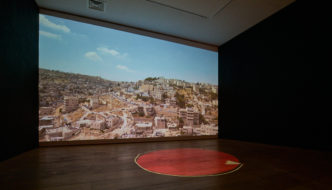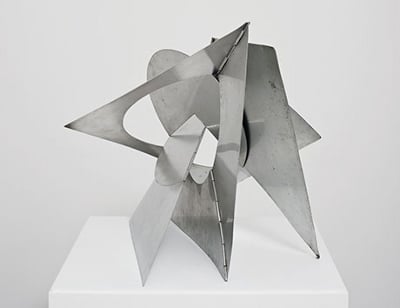Review: The Grammar of Order @ The Tetley
October 23, 2014
[Image: © Giulia Ricci]
The Grammar of Order was an experimental art and sound installation hosted by The Tetley as part of RECON festival 2014 (co-commissioned by Pavilion). It was the result of collaboration between artist Giulia Ricci and musician Tom Hopkins. The installation combined patterns, from Ricci’s piece: The Grammar of Order, and a score performed by Hopkins, who used the patterns to generate new sounds with human and abstract voices.
Before I arrived at The Tetley, I wasn’t sure what to expect. I had read the RECON programme and found it difficult to imagine how the patterns and music were going to interplay, and how the installation would be presented in a stimulating way. However, after drinking the mandatory free wine, which accompanies these events, I entered the space with an open mind.
Within the darkened room, projected onto a large screen the size of one of the walls, were Ricci’s patterns: each pattern appeared on the screen for two or three seconds and was then replaced by a slightly altered pattern. The patterns were elegant and managed to give the impression of being both simple and complex. They were made up of small and simple 2×2 grid units which contained an arrangement of triangles. This grid was then repeated, often mirrored or rotated, to create more complex 4×4 grids, which were themselves repeated across the entire screen to create the complexity of the full image. This method meant that a minute change of the position of a single triangle in the 2×2 grid had wide ranging repercussions on the image as a whole.
This intimate link between micro and macro worlds which Ricci’s work pointed to, evoked in me thoughts of chaos theory, in which the smallest changes in micro-conditions can have great effects across the board. Ricci states in his portfolio that he is “interested in the often unassuming but all-pervading presence of patterns and systems in the places we inhabit and in the objects that surround us”. His work certainly made me reflect on the way in which patterns are built up in nature and how we often find similar patterns at both the smallest scale and the largest scale; from the atom to the solar system.
Hopkins’ soundscapes were intricate, alternating between periods of smooth raindrop-like splashes of sound and more abrasive harsh noises. I was disappointed that the process by which he was interpreting the patterns was very hidden, meaning that the relationship between the visuals and the sound was not immediately obvious, and may not have been noticed by an observer who had not read about the installation before attending. However despite this, the soundscapes were interesting and the combination of ambient sounds and repetitive patterns worked together to create a very trance-inducing experience. By the end, I wanted to leave the installation but I felt almost incapacitated to move! I had been hypnotized by the monotony of the unfolding sequence of patterns and soundscapes. Whether or not this was the desired effect of the artists I am unsure.
My major criticism of the piece was its sheer lack of emotional energy or to use a much despised buzz-word in the philosophy of art: beauty. The patterns were rigid, technical, mathematical and logical, and were composed entirely of straight lines; whilst the music was atonal and arrhythmic. This meant the installation was of very low emotional impact and did not inspire a sense of awe or wonder, as, in my opinion, a good piece of art should. It felt as if the installation lacked a soul and the resulting trance-like state that it left me in was not one of relaxation or contentment, but one of emptiness and tedium. Despite this however, I enjoyed the intricacy and elegance of the patterns and ambient soundscapes, and found the installation conceptually interesting.
Danny Davis
Filed under: Art & Photography, Film, TV & Tech, Music
Tagged with: exhibition, installation, review, The Tetley



Comments